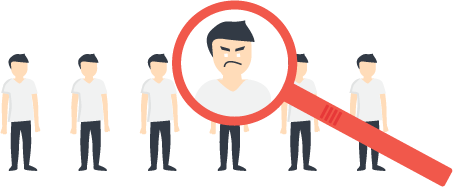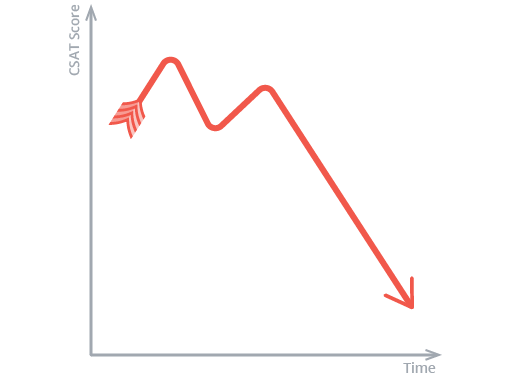Is your high CSAT score hiding your customers’ true feelings? At a previous company, we set ourselves an ambitious customer satisfaction goal: to raise the CSAT score from 90% to 95% in just three months. Our team sat down and brainstormed ideas on how to get there.
“What if we stop surveying cancellation requests?”
“Let’s only survey tickets that we solve in under 3 days!”
“We can exclude anyone who’s contacted us instead of our customers!”
Do you see the problem? While all of these ideas would definitely increase that CSAT number on our dashboard, none of them addressed our actual customer concerns. We were bumping up our own number, but hiding the problems we needed to solve.
The fact of the matter is that we were using CSAT as a vanity metric – a pretty number to pad our egos – rather than using each piece of feedback as an opportunity to improve the interactions we have with our customers.
But won’t it lower my customer satisfaction?
One of Nicereply’s features is the ability to add a survey to the bottom of every email. A common concern we hear against including it so frequently is that it might lower the overall customer satisfaction score. This idea has a merit. If we invite customers to share their feedback on every email (even before we resolve their concern) it is possible that you will see a decrease in positive satisfaction ratings.
Picture this:
A customer upset about a product defect writes to your support team. Your support team writes back and provides a link to a help center article. The customer never responds. Your support agents think they resolved the problem and closed the ticket. Two days later, you receive a seething reply to a customer satisfaction survey from that very customer. The problem is not solved … your support failed at impressing your customer, so he or she never replied!

Now, imagine including a satisfaction survey with every response. Instead of feeling like a client had to reply, the customer could have simply clicked on the sad face. They have given you feedback that the conversation had not been going in a positive direction, and someone on the support team could jump in to recover the situation. Right, your customer satisfaction score takes a hit, you have received the feedback you need to make the situation better.
Trello uses this practice of “tiny data” or constant opportunities for quick feedback to drive customer happiness. Emily from their support team explains that they, “Wanted to give our users another outlet to let us know about a case that may require extra attention.”
Being receptive to customer feedback (good or bad) does put your CSAT score at risk – but, we think, the gains are worth it.
What are you actually asking?
We have also talked a lot about how the questions you ask in surveys change the responses you get. A constant struggle for customer support managers is seeing what impact does it pose on their CSAT score when their clients complain about feature requests going unanswered, or ongoing product issues. Because a support manager has less influence in these areas, it feels like these matters are beyond their control, but they influence their key metrics.

A standard solution to this problem is to try and change the survey question in a way that refocuses only on the customer service a customer receives and ignores any product issues. I cannot help but think this is short sighted; do you not want a customer to express their frustration with a product issue just because it lowers your CSAT score number this week?
We’re all in this together, and every piece of customer feedback is good for business.
Seek out the Bads

Instead of trying to exclude customers who might incline to give you a bad survey rating, actively seek them out. Each Bad rating is another opportunity to talk openly and honestly with a customer and fix the root of the problem. Everyone loves praise – but your real learning opportunities come from the unhappy customers. To improve, seek out the bad surveys as much as the good.
Let customers know what their feedback means
Tell customers what happens when they leave feedback for your team. Who reads it? What happens with it? Letting customers know that you actually read their responses will encourage them to openness and they will be forthcoming with their opinions.
Give customers more opportunity to speak up
Ask customers for their opinions all the time. Include one-click feedback screens in your product or app. Ask them their thoughts when you are talking to them. Send them follow-up surveys. Your customers should never be more than two clicks away from reaching you.
Make it easy for them to talk to you
Avoid making customers jump through hoops to leave feedback. They are doing you a favor by helping you improve. For example: have you ever called the 1-800 numbers on your pop can to “leave feedback”? I bet you have not. Minimize the distance between your customer and your ears in any way you can.
Respond when they do give feedback
If you don’t respond, customers will feel like they are shouting into a black hole. React and address their concerns. Take action! Two way communication helps build relationships with customers. A customer will be much more likely to leave feedback in the future when they previously have had a good experience.
Don’t think of CSAT score as just a number

A CSAT score is the cumulation of feelings of real people. We, as customer service agents, have the privilege to move the needle, solve problems and figure out how to make the unsatisfied, satisfied. The next time you get the temptation to exclude rating responses or tell customers you are only interested in particular type of feedback, re-evaluate. A CSAT score is just a means to an end. Do you focus on the number or the people behind it?








